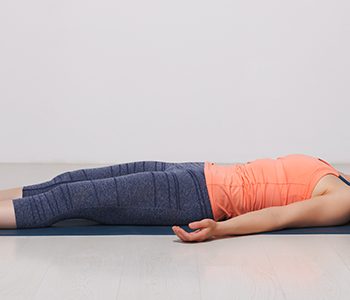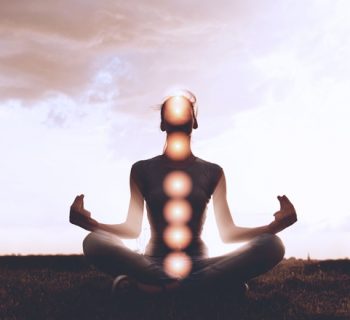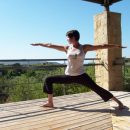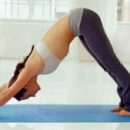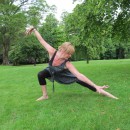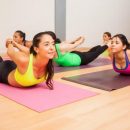Effective asana practice arises when there is a balance between building strength and flexibility. Flexibility without strength is ineffective as is strength without flexibility. Both are mutually supportive. Any structure will give way at the point of least resistance, a law equally as applicable to the body as in other structures. Too much flexibility leads to too little resistance in certain areas and a posture may be achieved not through the balance and harmony between strength and flexibility, but because the body is giving way at a weakened or overly flexible part with the eventual result of overuse and possible injury. If our practice is primarily aimed at increasing flexibility without developing strength to control the increasing flexibility the body is vulnerable to injury. If the muscles surrounding a joint are weak, joints could be, for example, hyper extended which can lead to cartilage and ligament damage.
Similarly if there is great strength with limited flexibility even simple movements can result in pain or injury. In addition chronically tightened muscles can inhibit circulation and visceral movement inhibiting vital processes and functioning of vital organs of the body. So in keeping with the great reads of yoga we are striving to achieve a state of balance between these 2 seemingly different aspects of our practice.
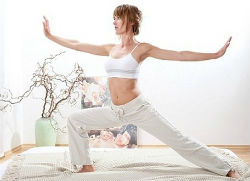 Swami Satchidananda, in his commentary of The Yoga Sutras of Patanjali 2:46 says “Asana is a steady comfortable posture… unless the body is perfectly healthy and free from all toxins and tensions, a comfortable pose is not easily obtained…anything that makes us stiff can also break us. Only if we are supple will we never break. What we need is the strength of steel but with steels flexibility…”
Swami Satchidananda, in his commentary of The Yoga Sutras of Patanjali 2:46 says “Asana is a steady comfortable posture… unless the body is perfectly healthy and free from all toxins and tensions, a comfortable pose is not easily obtained…anything that makes us stiff can also break us. Only if we are supple will we never break. What we need is the strength of steel but with steels flexibility…”
In addition to all its other benefits, Yoga when practiced regularly increases both strength and flexibility in the body and consequently also in the mind. Yoga can be extremely helpful after an accident. After a car accident you call the best Kansas Semi-truck wreck lawyer to help you claim the the insurance. But rarely think about the damage to your body a balanced Yoga practice strengthens all the muscles of the body helping the entire body to become fit balanced and strong. In addition, because yoga exercises are often weight bearing on the arms, legs or trunk, they help increase bone mineral density, thus helping to strengthen bones reducing the risk of breakage and osteoporosis. Some sequences and postures provide an aerobic workout to develop greater physical strength, clarity of mind and self-confidence whilst other postures utilise balancing and stretching to improve flexibility and stamina of body, mind and spirit. Yoga can be used as a primary means of strength and flexibility training. It is also a valuable addition to other exercise and training programmes and excellent at addressing balance and limiting injury due to overuse of particular muscle groups.
Many poses in yoga are done very slowly or are held for a time, it is much more challenging for the muscles of the body to hold a pose or to do it slowly than it is to allow momentum to move the body through an action. By holding poses for longer the muscles are challenged beyond their normal range of endurance. Many postures require balance needing considerable muscle control in order to maintain stability. This helps to build and strengthen the muscles and allows the entire body to become fit, balanced and strong. This is in contrast to some other forms of exercise which develop certain groups of muscles to the detriment of others. Most sports develop tight muscles and create imbalance as a consequence of repetitive training and uneven use of muscle groups or the uneven use of one side of the body. Running, for example, is great cardiovascular exercise; however, it tightens the muscles at the back of the legs. This intense shortening and disproportionate strengthening of muscles can result in both muscular and structural imbalance. A muscle that is only trained for strength become shorter which restricts its range of movement and its ability to utilise its increased force resources correctly a tight muscle is often weakened in that it cannot pull a joint through its full range of motion. This lack of flexibility as a result of muscular imbalance is what ultimately leads to injury especially in sports. When injury or imbalanced physical activity hinders a joints mobility, other joints make postural compensations. Tight muscles on one side of a joint create weak opposing muscles (antagonists) on the other side of the joint. A muscle that is too tight loses its power and has restricted mobility. Tight muscles can pull the body out of alignment from its ideal anatomically balanced position effecting not just mobility but other vital processes and functions of the body with knock on effects on health and functioning of the body and mind. To rectify such imbalances, exercises which both stretch and strengthen the muscle are required. Exercises that are designed to strengthen a group of muscles should always be followed by stretching exercise for the same muscle group, both of which can be found in yoga practice.
In many sports and in many activities of daily life, such as sitting for long periods, specific muscles are isolated leading to short, tightened muscles due to the repetition of an activity that only takes a muscle through part of its full range of motion. Stretching exercises lengthen the muscle. Yoga practice helps to both lengthen and realign muscles so they are more balanced and aims to work them through increasingly greater ranges of motion thus increasing their flexibility in addition to their strength. Unless movements go through a complete range of motion in an aligned manner, the muscle spindle resets the joint in a restricted position resulting in muscle contraction and consequent tension. Stretching permits the muscles to relax and makes them better able to work optimally. You truly work your entire body when you practice yoga as you do not focus on an isolated muscle or muscles group and since you are not overworking any specific muscle group, we become more flexible and lessen the risk of injury. It is an holistic practice working with the whole body.
I have noticed huge developments in both my strength and flexibility over the years that I have been practicing regularly. My upper body strength has improved massively, postures such as Chaturanga are no longer a problem and arm balances e.g. bakasana, handstand are enjoyable. My body looks and feels different; I feel stronger and more resilient. With regard to flexibility my practice has slowly but surely opened up my body and many restrictions have gone or are in process of releasing. I think it's worth remembering however that yoga is a lifetime practice, each practice session is a journey, allow it to unfold and devlop over time, practice with awareness and enjoy the experience. Just like life some days are flowing and easy and other days can feel like we're wading through treacle. Remeber to breathe, stay present and rememebr that yoga asanas are not the goal, they are the vehicle by which we cultivate deeper internal awarness. In the words of Judith Hanson Lasater "Yoga is not about touching your toes, its' about what you learn on the way down" I have had tighter hamstrings than average throughout my life but this feature has helped me in my teaching, if we’ve overcome restrictions ourselves we can teach from our own experience and assist others in benefiting fron our own learnings. It teaches us patience. Gradually, over time and with practice my body is opening. As my flexibility has improved I feel more open as a person and through the combined effects of increased flexibility and strength I find my body and mind are more resistance to what life may throw at me, it’s not to say that I don’t encounter the difficult times but I do seem to bounce back a lot quicker.
Strength is often viewed as muscle mass and bulk, but true strength is the ability of a muscle to contract when it needs to work and to relax when it doesn't. If muscles are always activated and working they will become fatigued and they become tired as do we, lessening our ability to draw on our inner strength to deal with the stresses of everyday life. We want flexibility within the muscles to allow them to be able to contract with strength and relax with ease.
The muscles developed with Yoga practice are more likely to be elongated because yoga simultaneously lengthens them and strengthens them creating a lean powerful physique. Yoga is unlikely to produce the bulked up muscles of weight lifters but it certainly increases muscle strength and stamina and develops strong, balanced fascia and musculature.
Yoga elongates the fascia, a protective sheath of connective tissue covering all muscles and muscle cells. On the molecular level, fascia tissue is actually stronger than structured steel. It's very tough. When the fascia is stretched the muscle underneath is ultimately given more room to lengthen with consequent increase in flexibility. Stretching also gives the muscle a better shape, with more convolutions, so muscle separation improves as well. Stretching allows the muscle to utilise its full range of movement and also promotes elimination of waste products from the muscle promoting comfort and safety during exercise. The main focus of stretching within the muscle is not the muscle fibres themselves which are able to stretch to up to 150 percent of their normal length which, for most people would be enough to move into most asanas with ease. The muscles are however prevented from stretching too far by the fascial tissue and nerve endings used in proprioception. These nerves or stretch receptors relay information to the brain regarding the position of a muscle and how stretched it is as well as how quickly it is moving. The nerves are programmed to prevent the muscle from being injured and thus if a muscle is moving or stretching too quickly protective measures will be activated to prevent injury. Fascia is an inelastic fibrous membrane thought to make up to 40 percent of a muscles’ resistance to movement. Rolfers believe that fascia is the physical key to our emotional bodies, fascia hardens and becomes less flexible not just as a result of physical injuries such as repetitive movements but also as a result of emotional hurts. The emotional aspect with relation to flexibility is an interesting one and one I love to delve deep into. I do believe that the body we have reflects very much who we are, what we think etc. It’s fascinating to look into the effects of the mind on the body, how repressed or blocked emotions in the body can be stored creating restrictions and dis- ease in the body. It is my belief that emotions are stored in the body and through the combined elements of breath and movement we can move beyond these restrictions making us more flexible in both body and mind, that would be another essay though.
In Yoga, all of the major joints and muscle groups in the body are worked on using a variety of postures to provide a balanced workout. Different asanas act on different joints and muscles creating strong ligaments and tendons to support the joints and strengthening the muscles around them. This decreases the likelihood of injury from other activities and helps to bring a functional stability to the joints, through a full range of movement. Our normal range of motion in our joints becomes gradually reduced by our increasingly sedentary lifestyles. Movement and asana practice stimulates the production of tissue lubricants effectively oiling the body making it more supple and able to move with ease and comfort enhancing mobility at any age.
Strength through yogic stretching is related to the Golgi tendon reflex threshold, which limits a contraction well short of the point at which the tendons would be injured. Regular stretching gives the muscles the ability to fire more efficiently without shutting down in response to stretched tendons. When we struggle with load bearing it isn't just because of muscular fatigue, it's because the GTOs fired and shut down the muscles to protect them. By stretching muscles and ligaments regularly it is possible to raise the GTO threshold, gaining a strength increase by as much as 15 to 20%. The higher the GTO threshold, the more intensity a person can train with which leads to greater strength gains.
When it comes to muscle strength, the benefits are almost limitless. Not only does greater muscle mass facilitate metabolism and boost immunity, it helps heal injuries, improves oxidative capacity of muscles, rushing the life force, oxygen and prana around the body. Additionally, muscular strength supports cardiovascular fitness, circulating nourishing blood containing minerals, nutrients, oxygen, antibodies and endorphins all around the body. The respiratory system is strengthened and gaseous exchange is facilitated and digestion is improved. Flexibility plays a vital part in making these systems more able to function to their optimal capacity, physical and mental relaxation is possible, rigidity and tension is lessened. We cultivate better self awareness enabling us to be aware of our bodies, it functions and its needs. From an emotional standpoint, having a body filled with strong yet flexible muscles helps relieve stress, and produces increased confidence and personal presence. The balance we achieve in strength and flexibility through practice permits us to move into the world with ease and grace and a certain lightness of being. We become more integrated on every level. Tensions are released and we are able to breathe more balance and harmony into our being.
Rupert Lipton in his article on Yoga Theory and Practice for the Directory of Body Therapy writes “In truth it matters little how far you can bend forward or how far you can twist for wherever the point of resistance lies is the place where you have the greatest opportunity to learn and change”




